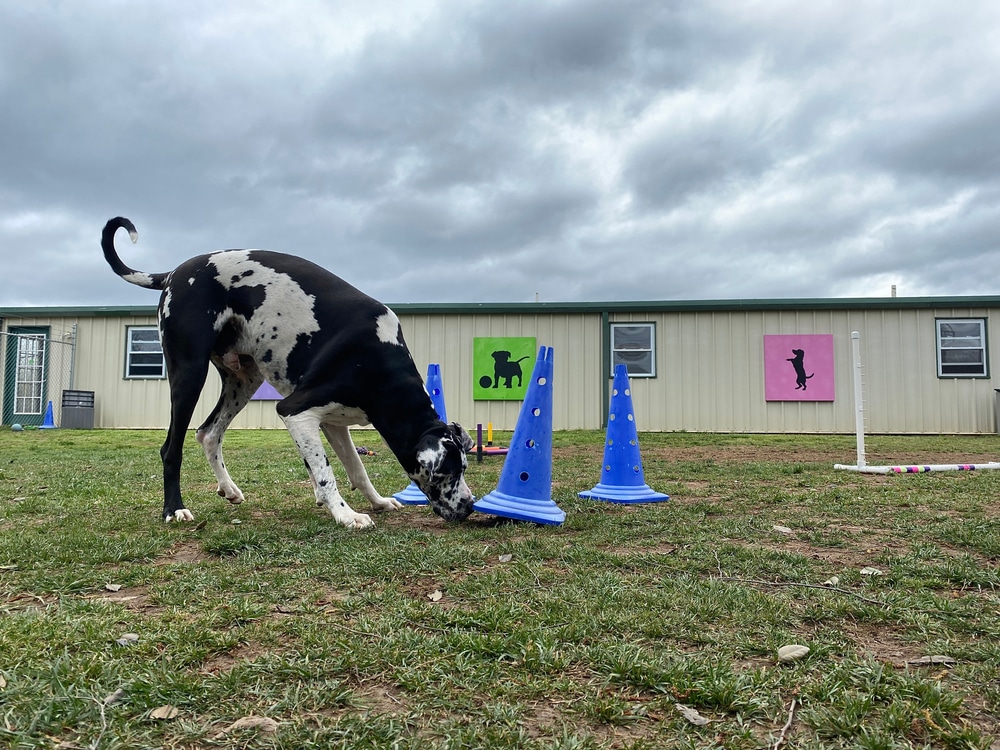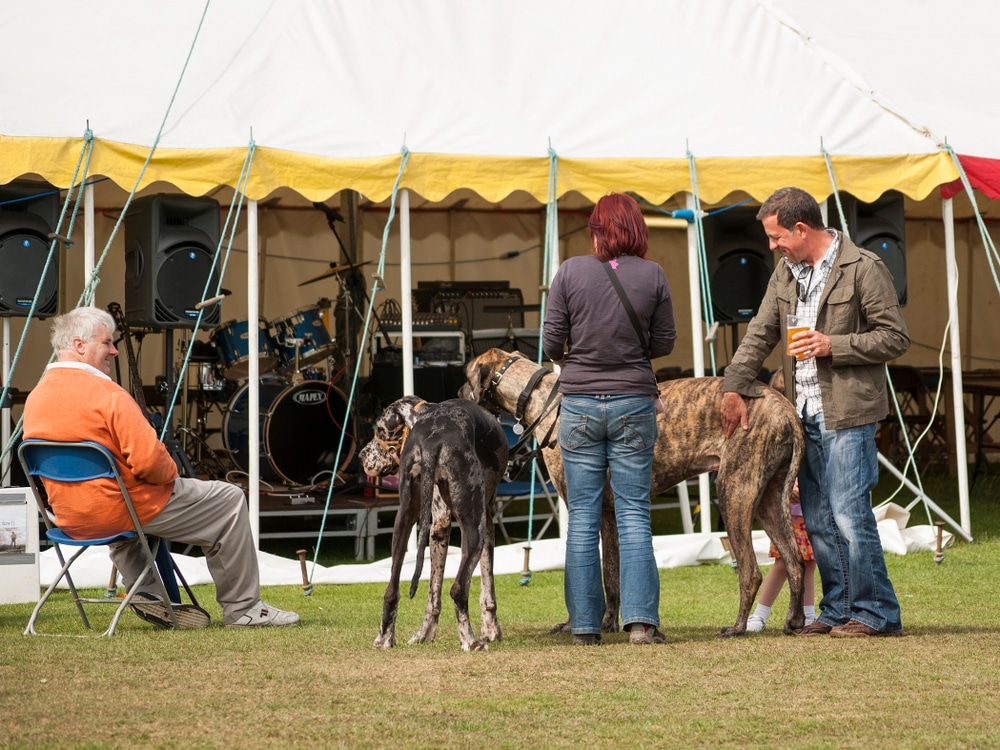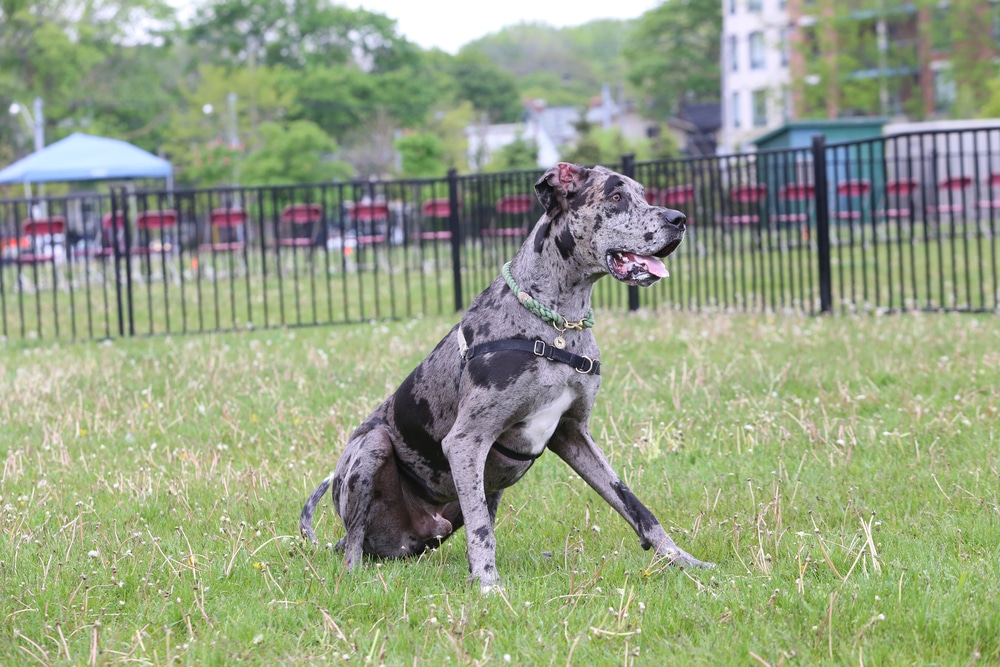“This post contains affiliate links, and I will be compensated if you make a purchase after clicking on my links.”
Last Updated on November 3, 2022
Great Danes are a large, beautiful canine breed. Because of their intimidating size and incredible strength, making sure they’re always in their best behavior is necessary. And training them plays an important role in this.
But the question is: is training a Great Dane difficult? Of course, Great Dane training will require time, effort and patience. But it isn’t as difficult as it seem to be.

It’s easy to assume that Great Danes are difficult to train due to their intimidating presence. However, unlike other breeds, their warm and easygoing temperament serves as a perfect counterbalance to their huge size.
If you are afraid to start or need some guidance to start Great Dane training, then this article is for you. Continue reading to find out how to train your Great Dane confidently and effectively.
Are Great Danes Dangerous?
Like any other dog breed, Great Danes can only be dangerous if not trained properly.
Seeing a huge Great Dane can evoke fear and intimidation especially for those who have not met such huge dogs before. Considering the size and stature of the dog, it is natural for many people to reason that Great Danes can be dangerous.
However, Great Danes are innately friendly, loyal, playful, warm and their behemoth presence usually grabs everyone’s attention. They are not known as ‘gentle giants’ for nothing! However, even the most gentle dogs still need training and disciplining.
While it is true that Great Danes are friendly dogs and can get along well with other pets, their temperament also suggest that they are quite possessive with their loved ones, especially with their owner.
In saying this, it can be deduced that Great Danes might pose some danger to strangers, especially if these people are trying to cause harm to their loved ones.
Training a Great Dane
A Great Dane’s characteristics are a combination of nature and nurture. While it’s true that they’re naturally social dogs, not letting them meet new people, other animals and new environments will be troublesome for both the owner and the dog.
Great Dane training should start as early as 8 weeks. Starting late may be a problem because the bigger and older they get, the more stubborn they become. So, starting training as early as possible is important. Furthermore, puppies are easier to train, in the sense that they still haven’t acquired any bad behaviors or habit unlike adult dogs.
Furthermore, training should include crate training, housebreaking, leash training, obedience training and socialization. Among the many things that a Great Dane must learn during training, socialization is the most crucial.
Why is Great Dane Training Important?
Great Dane training will ensure that the good characteristics that your Dane is born with will be nurtured correctly. Proper training will make a confident, calm, social and healthy Great Dane.
Generally, dogs misbehave in a lot of ways. They can be disobedient, chew on furniture, jump at people or bark excessively. However, they do not understand that such actions are “bad” and have consequences. With training, they will understand the difference between good and bad. And they will learn that certain actions will not be tolerated.
If you’ve had your Great Dane dog for a couple of weeks, you must have realized the importance of Great Dane training by now. You will agree that disciplining them is as important as proper grooming and proper nutrition, if not more so.
Types of Great Dane Training
There are different types of training that your Great Dane must undergo to ensure they grow up to become well-behaved and healthy dogs.
See below for the most important trainings that your Dane must undergo:
Socializing

With Great Dane training, socialization needs to start as early as 8 weeks. This is because at such age, developing the dog’s social skills will help them develop better behaviors.
Great Danes can be intrinsically possessive of their owners. If a Great Dane puppy is not socialized well, it might become too possessive of its owner and will not know how to behave appropriately in different situations.
As a puppy, you need to introduce your Great Dane to a lot of healthy life experiences – meeting people and fellow pets at the park, having play dates with other dogs, bringing over friends at home, or even simple walks where they get to encounter new environments.
The people around the Great Dane, like you friends and family, make up the pyramid of the dog’s social fabric. For your puppy, you are on top of that pyramid, and then comes your family, and then your friends. And interacting with all three levels is crucial for your puppy to develop good behaviors and a smooth relationship with everyone around you.
Furthermore, without proper socialization, behavior issues like incessant barking can become a problem. Great Danes can bark at anything new they encounter – people, environment or pets. Dog trainers suggest that Great Danes are latent loud barkers. And with how huge they are, there is no doubt that their barks can be loud.
Leash Training
Whenever you want to go outside with your Great Dane for a stroll, putting it on a leash is a must. A smooth stroll outside can be difficult without proper training. Hence, the need for leash training.
Leash pulling can become a major problem if you don’t leash train your Great Dane. With how big and heavy they become, it can be troublesome if they start pulling on their leash while they’re outside.
You have to teach your Dane that knowing how to behave properly while on a leash is crucial to its outdoor activities.
Housebreaking
Housebreaking appear one of the hardest things to teach Great Dane puppies. It can usually take 4 to 6 months for a puppy to be fully house-trained. But it can be manageable if you create and maintain a routine with them.
Crate Training
Naturally, dogs like and enjoy a comfortable, quiet and safe place for themselves when their environment becomes too overwhelming for them. And crate training takes advantage of this.
Crate training is essential and doesn’t mean “caging” dogs in a crate.. It helps create a safe space for your Great Dane and can help calm their anxiety. It can also help make other training techniques easier, like during potty training. Moreover, you can safely transport your Dane in a crate with this training method.
A dog values their crate as much as you value your home. So it’s important to help them establish this attachment with their crate.
Potty Training
This type of Great Dane training method teaches your dog when and where they should do their business. Potty training usually goes hand-in-hand with crate training as a crate is an ideal tool that a Great Dane can use to potty.
Usually, puppies learn how to potty easier when you create and maintain a schedule for them. For example, after their meals, lead them to their crate and wait for them to do their business. If you do this after every meal, they will start to understand that the right time and place for them to do their business is after a meal, on their crate.
Great Dane Training: Is It Easy or Difficult?
Generally, Great Dane training is not a difficult task. Though some owners might find it difficult because their Great Danes can be stubborn and moody sometimes.
There are many factors to consider when training a dog – their age, their characteristics, your training methods and consistency to name a few.
Fortunately, Great Danes are a dog breed that are naturally loving. They adore their owners and are known people pleasers. And such characteristics can be beneficial and can make training a lot easier.
Great Dane Training Tips

There are many Great Dane training methods you can use to train your dog. Some people suggest firm, dominating methods where trainers/owners do not hesitate to impose penalties for their dog’s bad behaviors. Most of the time, such methods are counterproductive and lead to more unpleasant traits.
Furthermore, imposing punishment methods like hitting, spanking or slapping during training can make your Great Dane stubborn instead of well-behaved.
To create an effective yet positive experience for your Great Dane, here are a few tips to train them:
1. Be Firm
Having respect for their human family and creating a bond is an important aspect of Great Dane training. You must teach them to respect your commands without instilling fear in them.
Telling a Great Dane off firmly is the first step in establishing this respect and bond. For example, since Great Danes are inclined towards jumping, especially when they get excited, you have to break the habit as early as possible.
(Note: Jumping excessively to express excitement is not all that bad. However, imagine a 120lbs dog always jumping towards you, now that would be a BIG problem!)
When they start to jump excessively at you, you need to tell them “No” with a stern and firm voice. Your Dane needs to understand and respect that doing too much of a certain action cannot be good.
Basic Commands Training
A Great Dane has to learn simple commands which prove to be useful in everyday life. Aside from saying “No” to tell them off, you can also kick off Great Dane training with these basic commands:
- Come: The purpose is to signal your command to come back to you, especially when they’re about to do something bad.
- Sit: The purpose is to calm your Dane and help them develop self-control.
- Stay: It has the same purpose as the “Sit” command.
- Heel: This is to teach your dog to behave well when you are beside them, especially when going on a walk.
- Down: This is to calm down an excited Dane and to address issues like excessive jumping.
- Quiet: It’s usually used to train your Dane for their incessant barking.
Being a Great Dane owner, you are required to train your dog to follow these simple commands. This training will not only discipline the Dane but also help establish respect between you and your dog.
2. Be Consistent
Correcting their behavior should not be a one-time thing. You have to be consistent in your commands and the training. If you repeat your commands every time your Great Dane misbehaves, the dog would misbehave less thanks to your disapproval.
Furthermore, when you see a pattern in their stubborn behavior, you have to consistently and firmly tell them that such actions are inappropriate.
Associating a gesture or signal with each of your command can also be helpful. This can improve your communication and making learning easier with your dog. Once you’ve chosen a certain signal with your command, do not change your signals and/or commands. You have to use it consistently so that your Great Dane would not get confused.
With repetition and consistency, your Dane will soon learn how to behave correctly. And they’ll learn that some actions or behaviors will not be tolerated.
Dog Pack Behavior
Naturally, dogs are pack animals and are used to living in a social group. When you get a Great Dane, it will assume that you and the rest of your family are its pack.
If you, the owner, does most of your Great Dane’s training, it will view you as the Alpha of the pack. And with consistent training, your Great Dane will respect all of your commands.
In addition to this, you also have to teach your Great Dane to respect all members of the family. Letting family members join training sessions or letting them feed your Dane will help. This will also teach your Great Dane that they are at the bottom of the pack.
3. Reward proper behavior
Great Dane parents and trainers alike reward even the smallest successes. And when you reward proper behavior, you are creating a positive association with training. Because of this, Great Danes are more encouraged to repeat good behaviors.
Positive Reinforcement
Positive reinforcement is an effective Great Dane training strategy. Many Great Dane dog parents and trainers emphasize on this gratifying technique to train Great Danes. Using this during training sessions might help your Great Dane learn new things better and training can be a lot easier than anticipated.
This strategy uses treats, praise or anything that your dog finds rewarding when they do something good or follow your commands correctly. And it discourages the use of any form of punishment as a tool to train your Great Dane.
You can also use additional behavioral techniques with positive reinforcement during Great Dane training. You can introduce favorable behaviors to replace bad ones.
For example, if your Great Dane has a habit of biting or chewing, provide chewing toys for them to bite or chew on. Encourage them to use the toy, and when they do, praise them or give them a treat.
4. Get Professional Help
If Great Dane training with you (the owner) is not working and becomes counterproductive, then it’s time to hire a dog trainer. You have the option to enroll your Great Dane in a group class with other dogs. Or you can hire a personal trainer who can work solely with your Great Dane.
Determine what your Great Dane needs the most. Does it need to learn basic commands? Does it have behavior issues like barking or jumping excessively? You have to look for something that will suit you and your dog’s needs.
What Do We Recommend

Of course, nobody wants to have a huge dog that has an unruly behavior. That’s why Great Dane training is, without a doubt, essential.
We hope that with the tips and information we provided, you can ensure that the training will clearly establish boundaries and communicate that certain actions are just not acceptable.
With consistency, patience, the right attitude and the correct methods, Great Dane training becomes easy and fun for both the owner and the dog. And in no time, you’ll be rewarded with a healthy, social, well-behaved and obedient gentle giant!
1 thought on “Why Great Dane Training Is Important”